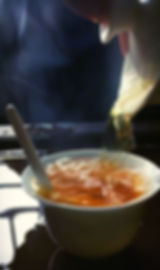Blog 4: The Water For Making Tea
- Valley Brook Tea
- Mar 29, 2018
- 2 min read
Updated: Oct 18, 2018
Most tea lovers are passionate about the tea they have, but few have considered the water they use for making tea. In fact, water contributes the most to a cup of perfect tea. Our teamakers always say: a good serving of tea is “30% tea, 70% water”(三分茶,七分水). Today, let’s talk about the water we suggest for making tea.
Traditionally, Wu-Yi teamakers, such as our tea master Mr. Wang and Mr. Xue, are used to categorize water into 3 different grades(from most desirable to least desirable): up water, middle water and down water. Up water, or 上水, is the water from a mountain. Specifically, the water that flows slowly through mountain rocks. Middle water, or 中水, is the water taken from a river far away from the crowd. Finally, down water, or 下水, is the well water. My favorite is the mountain water from village of Tong-Mu, where our black tea mountain is. Black tea made with Tong-Mu water is marvelous. It actually has some oil-like quality, and every drop lingers on the cup. In fact, we ship water directly to some of our customers in China.

“Good" water, like the water in Tong-Mu, can enhance the taste, and “bad” water can potentially ruin the tea. In modern days, most water we can get is “down water”, public water from pipes. Water across the globe has different qualities. Water that has too much calcium is too hard and not ideal for making tea. Unfortunately, high-calcium water is more common. Most unfiltered tap water in North America is too hard to be used for premium tea. Tea made with high-calcium water has very dim color and numb taste. I personally have experienced a couple accidents that water failed the tea. This is why I only use bottled spring water for all my tea events.
If you want to have the best tea tasting experience, I highly recommend using bottled spring water and a dedicated kettle for cooking water. Remember, water comes first, then tea.
If you have any questions regarding this topic, please leave a comment, or tweet us @valleybrooktea .
